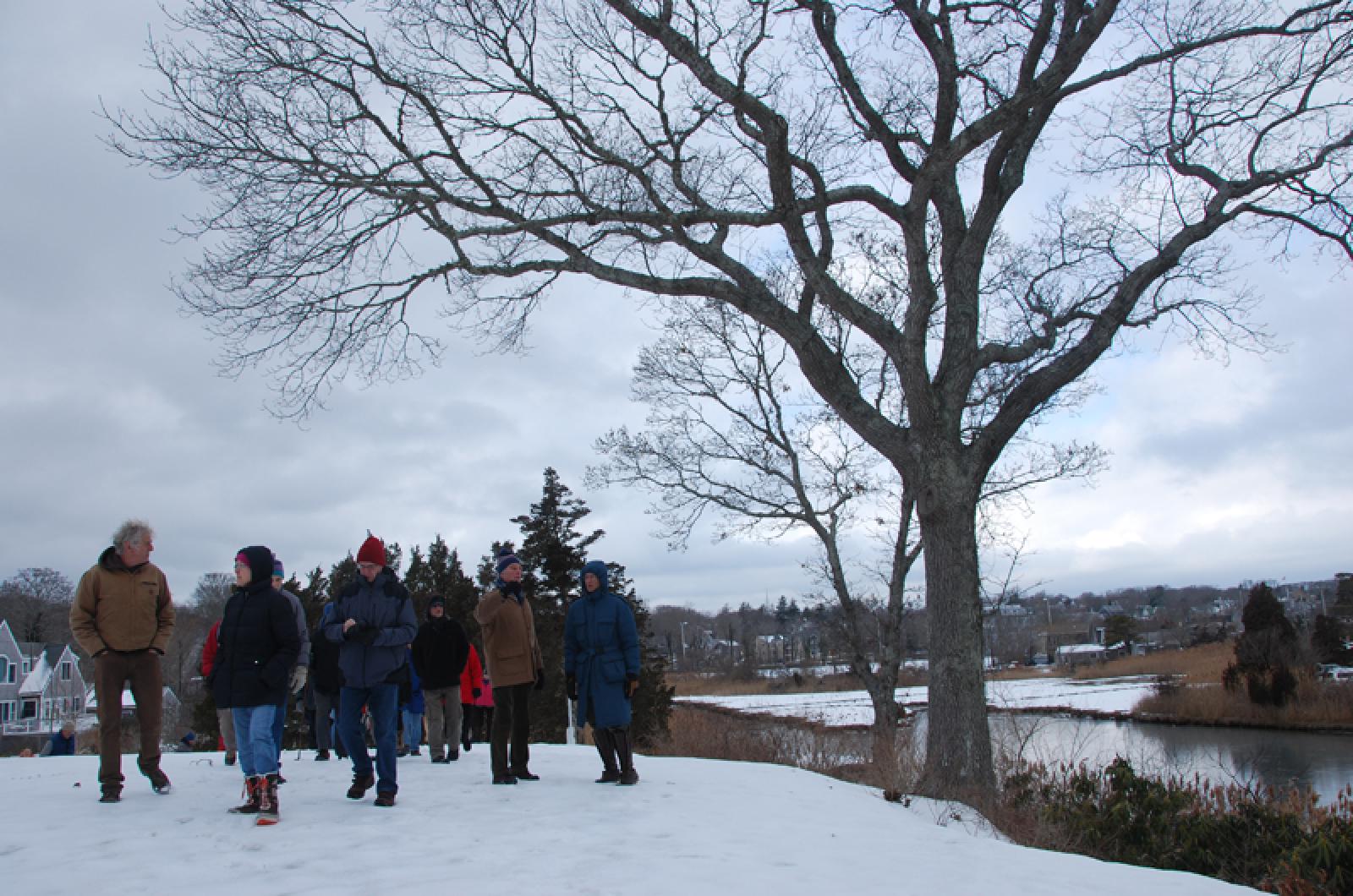With our seas rising and shorelines receding (all while the population keeps growing), it feels as though the Vineyard gets a little smaller every year. But one town, Vineyard Haven, is actually a bit bigger than it once was. A complex barrier beach and estuarine system once existed in the area of Five Corners, but has since been filled in and converted to buildable land.
The history of these waterways and estuaries, as well as today’s flat expanses of land behind the town post office, along Lagoon Pond Road and at Veteran’s Memorial Park, was the subject of an interpretive walk hosted early this month by the Vineyard Conservation Society. More than 40 walkers set out from the post office for a two-hour exploration of the past and present state of this part of Vineyard Haven. With vintage photographs, maps, and firsthand accounts, the pervasive nature of change was dramatically illustrated. An interesting history in its own right, but with the proposed changes currently under consideration (most specifically, the new Stop & Shop), it is a book whose next chapter is currently being written.
Two hundred years ago, Bass Creek brought sailing vessels of all kinds into Lagoon Pond. Near the present location of the Steamship Authority parking lot, a navigable waterway of six to seven feet in depth emerged through an opening in the barrier beach. It formed a curving arc past the present Stop & Shop and Five Corners, eventually widening into the Bass Creek. The creek then flowed southward (following present-day Lagoon Pond Road) into the lagoon.
Today, Bass Creek is no more — the creek and surrounding tidelands were filled over time with dredge spoils from the harbor, and with a variety of marine debris, including wreckage from the great gale of November 1898. About that particular storm Vineyard Haven resident historian Jim Norton wrote: “That mighty gale brought home with dramatic intensity how subject to the natural elements the fragile quality of human endeavor on the harbor had always been.”
But in its time, Bass Creek was a valuable resource, coming to the aid of residents in at least one notable crisis. In September of 1778, dozens of British warships carrying more than 4,000 troops moored in the harbor and forcibly re-provisioned themselves. More than 10,000 sheep, 300 oxen, and all manner of goods and possessions left town with them. That winter was especially harsh on the Island, and there are accounts of the impoverished town residents surviving on bass cut from the frozen Bass Creek.
The area of Bass Creek itself is now occupied by more than two dozen structures. These buildings, on the east side of Lagoon Pond Road, run roughly from the bike shop to the former Erford Burt boat yard. That boat yard, assembled in 1944 from the recycled North Tisbury Baptist Church, was whimsically referred to as the Bass Creek Meeting House.
On the opposite side of Lagoon Pond Road, the houses along Chicken Alley (named for the subsistence gardens that once thrived in the back yards) once had Bass Creek waterfront at their doorsteps. During the whaling era, the Legion (Veterans Memorial) Park behind Chicken Alley was an estuary, navigable at high tide. Whaling boats were hauled out at the head of the future park into a glacial ravine known as Cat Hollow, where a tar works was set up for repair work. (Cat Hollow is today a quiet, treed treasure conserved with a conservation restriction gifted by landowner John Hughes and facilitated by VCS.) But following the 1938 hurricane, mountains of sand spoils from harbor dredging were deposited on the Bass Creek and Legion Park area, earning the local name of Sahara. It was eventually leveled and loam brought in under the auspices of the local Legion Post number 257, a project launched after the second World War. The field was conveyed to the town and officially dedicated in 1964.
Even with all the changes, traces of the past remain: the outlines of the Bass Creek are still clearly visible in aerial photos, and maps reveal how the patterns of construction followed its contours. Will the Bass Creek return some day? It’s much too early to know, but in this era of rising seas it is inevitable that some of our engineered human habitats will be some of the first lands taken back by the ocean.
Brendan O’Neill is executive director of the Vineyard Conservation Society.







Comments (1)
Comments
Comment policy »